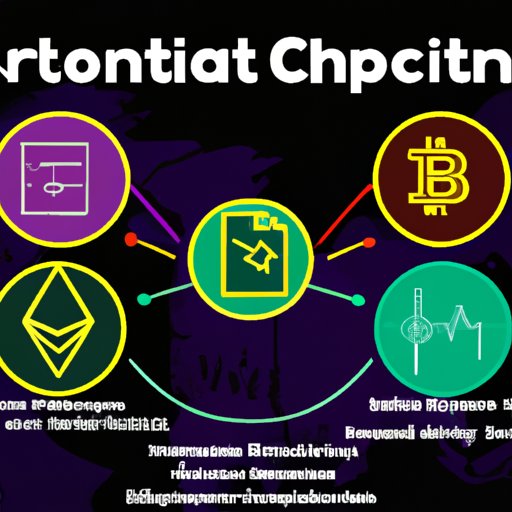Introduction
Cryptocurrencies are digital assets that can be used as a medium of exchange, or form of payment, for goods and services. They are decentralized, meaning that they are not controlled by any government or central authority. As a result, they have become increasingly popular over the past few years and have been adopted by a range of businesses and organizations worldwide.
Given the potential of cryptocurrencies, many people are interested in creating their own. This article explores how to make a cryptocurrency, from defining your goals to launching your currency and promoting it.
Overview of the Process for Creating a Cryptocurrency
Creating a cryptocurrency is a complex process that involves a range of steps, including:
- Defining your goals
- Choosing a platform
- Developing your cryptocurrency
- Testing your cryptocurrency
- Launching your cryptocurrency
- Promoting and marketing your cryptocurrency
In addition, there are various technical requirements for building a cryptocurrency, such as understanding blockchain technology, selecting a programming language, writing a whitepaper and setting up a mining network.
Step-by-Step Guide to Creating a Cryptocurrency
This section provides a step-by-step guide to creating a cryptocurrency.
1. Define Your Goals
Before you start creating your own cryptocurrency, it is important to define your goals. What do you hope to achieve with your cryptocurrency? Are you looking to create an alternative form of money, or a tool for transferring value between individuals? Do you want to use it to facilitate transactions on a particular platform? Answering these questions will help you determine what features your cryptocurrency needs to have.
2. Choose Your Platform
Once you have defined your goals, you will need to select a platform on which to build your cryptocurrency. There are several platforms available, such as Ethereum, NEO and Qtum. Each platform has its own advantages and disadvantages, so it is important to research each one before making a decision.
3. Develop Your Cryptocurrency
Once you have chosen a platform, you can begin developing your cryptocurrency. This involves coding the blockchain, designing the user interface, setting up nodes and miners, and creating a wallet. Depending on the complexity of your cryptocurrency, this process could take anywhere from a few days to a few weeks.
4. Test Your Cryptocurrency
Once you have developed your cryptocurrency, it is important to test it thoroughly to ensure it works properly. You should also test the security of your cryptocurrency, as well as its scalability and performance.
5. Launch Your Cryptocurrency
When you are satisfied that your cryptocurrency is functioning correctly, you can launch it. This involves releasing your cryptocurrency on an exchange, where users can buy and sell it.
6. Promote and Market Your Cryptocurrency
Once your cryptocurrency is launched, you will need to promote and market it. This can involve advertising your cryptocurrency on social media and other online platforms, as well as attending conferences and events to raise awareness.

Technical Requirements for Building a Cryptocurrency
In addition to the steps outlined above, there are certain technical requirements for building a cryptocurrency. These include:
1. Understanding Blockchain Technology
Creating a cryptocurrency requires a thorough understanding of blockchain technology. It is important to have a good grasp of the fundamentals, such as distributed ledgers, consensus mechanisms and smart contracts.
2. Selecting a Programming Language
The next step is to select a programming language for your cryptocurrency. Popular languages for creating cryptocurrencies include C++, Python, Java and Solidity.
3. Writing a Whitepaper
A whitepaper is an essential document for any cryptocurrency project. It outlines the purpose and features of your cryptocurrency, as well as any future plans. It is important to make sure your whitepaper is clear and concise.
4. Setting Up a Mining Network
Finally, you will need to set up a mining network for your cryptocurrency. This involves connecting computers to the blockchain, which will verify transactions and add new blocks to the chain.

Resources for Further Information on Cryptocurrency Creation
If you are interested in learning more about creating a cryptocurrency, there are a range of resources available. These include books, online tutorials and forums.
Books
There are a number of books available on cryptocurrency creation, such as “Blockchain: The Complete Guide to Understanding the Technology Behind Cryptocurrency” by Chris Burniske and Jack Tatar and “Cryptocurrency Investing Bible: The Ultimate Guide About Blockchain, Mining, Trading, ICO, Ethereum Platform, Exchanges, Top Cryptocurrencies for Investing and Perfect Strategies to Make Money” by Alan T. Norman.
Online Tutorials
If you prefer a more hands-on approach, there are a number of online tutorials available. These provide step-by-step guides to creating a cryptocurrency, as well as advice on the technical aspects of development.
Forums
Finally, there are a number of forums dedicated to cryptocurrency creation. These are a great resource for finding answers to any questions you may have, as well as connecting with other developers who are working on similar projects.
Conclusion
Creating a cryptocurrency is a complex process that requires a range of skills and knowledge. This article has provided an overview of the process, as well as the technical requirements for building a cryptocurrency and resources for further information.
(Note: Is this article not meeting your expectations? Do you have knowledge or insights to share? Unlock new opportunities and expand your reach by joining our authors team. Click Registration to join us and share your expertise with our readers.)
